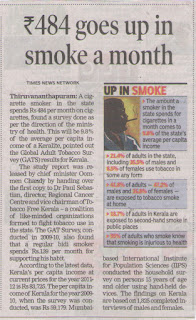
India has mooted the introduction of a designated "sin tax" to finance a part of the health budget during the 12th five year plan (2012-2017).
The 12th plan document, to be submitted to the National Development Council (NDC) presided over by Prime Minister Manmohan Singh, says "a sin tax can lead to reduced consumption of harmful items such as tobacco and alcohol and could be considered".
The move is part of the health ministry's larger plan to combat non-communicable diseases like cardiovascular diseases, diabetes, cancers and chronic respiratory diseases which are emerging as major killers.
The document for NDC says a package of policy interventions would be taken up which includes raising taxes on tobacco, enforcing ban on tobacco advertising in electronic media, counselling for quitting tobacco, early detection and effective control of high blood pressure and diabetes, screening for common and treatable cancers and salt reduction in processed foods.
Around 275 million Indians consume tobacco which has 3,095 chemical components of which 28 are proven carcinogens that can cause cancer. Around 2,500 people die every day due to tobacco related diseases in India.
Source: Times of India
Image courtesy: Jai Maharasthra News


































.JPG)